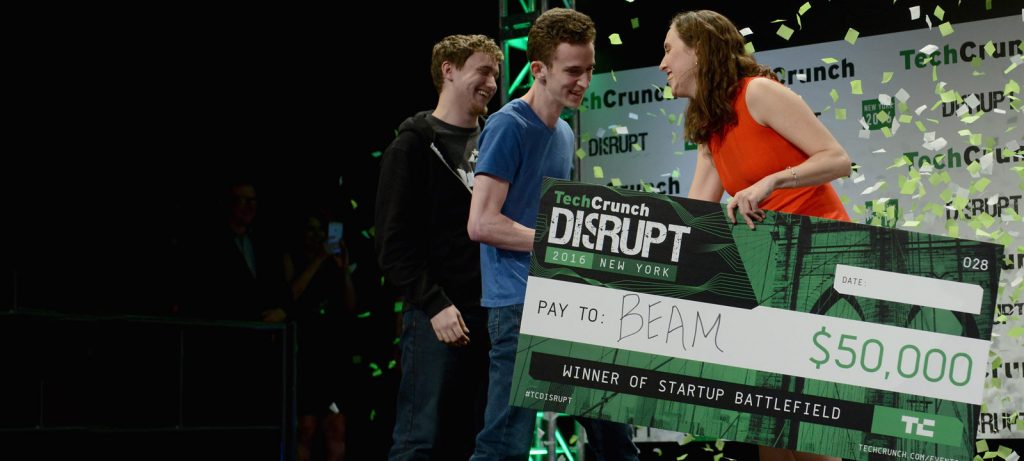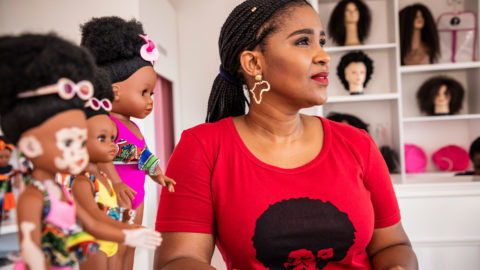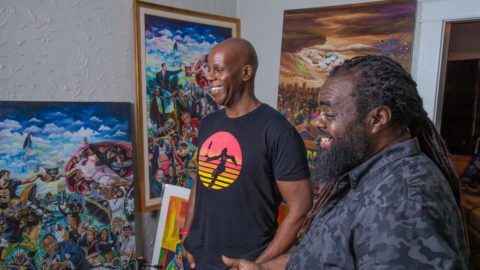The road to Mixer: how teen startup founders leveled up the future of live streaming
Scrappy, do-what-it-takes moxie transformed the two young hobbyists into burgeoning entrepreneurs. Microsoft noticed.
Matt Salsamendi and James Boehm released their alpha product under the website name “chilly dot cool.”
If that sounds somewhat adolescent, it’s because Matt and James were, in fact, adolescents when they launched their first startup, a company so successful that Matt dropped out of high school to help build it.
The stunning success they achieved at just 13 and 15 years old still seems like a fairy tale. What began as James’s community gaming server grew into the duo’s multimillion-dollar company well before either had even graduated high school. They pivoted their hosting service to live game streaming, named it Beam for its faster-than-light latency, and went on to win TechCrunch Disrupt NY 2016, an annual technology startup contest. In August of 2016, Microsoft acquired Beam, now known as Mixer.
Today, Matt and James are 19 and 21 years old, respectively, and have joined up with Xbox on a shared vision: to build a vibrant and interactive gaming community.
Choose your players
Matt’s and James’s origin story begins online, in the virtual world of Minecraft.
In 2011, Matt was 13 years old and lived in Ft. Lauderdale, Florida. He’d started hosting servers for gamers and friends on Minecraft as a hobby.
“I had a bunch of desktop computers that I would build from whatever parts I could get my hands on,” said Matt. People would send Matt $10.00 via PayPal and, in a flash, they’d have their own gaming server, which allowed them to modify a game and give permissions to only certain players, among other things. Essentially, people could host their own version of a game.
At one point, Matt had to get a loan from his dad to buy the software he needed to connect servers. “I went outside and asked him, ‘Hey, can I borrow $7.00? I’m doing this cool thing,'” Matt said.
His dad gave him the money, and word of Matt’s hosting service spread through the Minecraft and gamer community. James, then 15 and living in Atlanta, Georgia, saw an advertisement for Matt’s hosting service and reached out to him.
They became online friends, and soon they both realized that they were on to something with Matt’s servers. James suggested that he come on board to help make Matt’s business more official and grow, using his also-home-grown skills in business development and marketing. The demand for service kept mushrooming and eventually outgrew Matt’s setup, which consisted of a bunch of PCs stacked under his desk at his parents’ house.
Not only was there not enough space for the PCs, but their setup couldn’t keep up with the demand for networking capacity, power, and internet speed. So they migrated Matt’s home lab to a bona fide datacenter and named the company MCProHosting.
From 2011 to 2014, that first $7.00 investment grew into a company worth nearly $5 million.

2014 was also Matt’s freshman year of high school. He was working full time building a company and trying to keep up with his studies and social life. If the servers went down, James would have to call Matt’s mom, who would then check Matt out of school so he could come home to fix the servers.
But outages wait for no mother. “One time in the locker room after PE, I jumped into a locker to hide there because we couldn’t have phones at school,” Matt said, laughing. “I took out my phone and restarted the server to get it back online.”
This scrappy, do-what-it-takes moxie is what transformed the two young hobbyists into burgeoning entrepreneurs. As agile as they were, their balancing act and their company wouldn’t last if they couldn’t find a way to scale. Matt and his parents made the difficult decision to pull Matt out of school altogether when he was in his freshman year of high school.
“I could already support myself, and I needed to focus on where this thing could really go,” Matt recalled. “It was hard to argue with a million-dollar company that was still growing.”
Matt dropped out of school, and not long after, the duo decided to pivot away from the server hosting business and focus on game streaming—a pastime that was massively growing in popularity.
They launched a small alpha version of a website where people could stream games, get low-latency broadcasts, interact with their chat communities in real time, and discover other streamers. The goal was to let fans play along with their favorite streamer and to connect broadcasters to their communities in ways that were never possible before, Matt explained in a blog post.
It started small, but very soon they were up to 10,000 users. Then 20,000. “When we reached 20,000 people using it every month, we knew there was something there,” said Matt. In January of 2016, they launched Beam.
Microsoft Ventures caught wind of the service, intrigued by the opportunity in this growing space, and in August of 2016, Microsoft acquired Beam. Matt and James moved across the country, bought a house in Redmond, and started their lives as roommates and Microsoft employees.
Leveling up with live streaming
Let’s take a quick break here to discuss video game live streaming, for those of us who aren’t familiar with the billion-dollar industry. Matt uses this analogy: just like fans sit and watch their favorite sports game, video gaming fans like to watch their favorite video game “athlete.” YouTube and Twitch pretty much dominated this market in 2014, but Matt and James were irked by how both platforms seemed to separate rather than connect the streamer and the fans.
Gamers to the core themselves, the two really came alive when they connected to the community of the games they love to play. (James has been playing Halo on Xbox since he was 8 years old. And Matt wouldn’t even guess how many hours he’s spent playing Age of Empires, his all-time favorite game.)
So they knew the market was hot for a platform that felt like you were sitting right next to your friends while they play, giving them advice and ideas in real time that could actually affect the outcome. On YouTube, fans could leave comments but not chat in real time. Twitch had a chat feature, but its painfully high latency made the experience a literal drag.
Latency is more than an annoyance. Think of the live sports analogy again: imagine that you won the chance to choose the plays for your favorite player, but instead of having a direct line of communication to make snap decisions quickly, you were stuck in a locker room, shouting advice at a TV screen. Obviously, the athlete would never hear you, your advice would be outdated, based on a play that’s already finished, and your influence on and connection to the whole experience would be lost.
“We wanted to solve the real-time feedback incorporation problem, if only for ourselves while we were watching gaming broadcasts,” said Matt. “But we knew it went beyond what we wanted, that there was a huge need for it.”

“When we started growing Beam, we knew that the only way to succeed from a product standpoint would be to build the things that people want to see,” said Matt.
Keeping close to gaming culture and building things they’d want as gamers themselves was their golden rule back when they considered Beam’s future options, including the possibility of signing with Microsoft.
James said that from early on in their partnership, they’ve had a shared philosophy of helping grow others and solving real problems for what they want and need. And ultimately, that’s what won the Beam team over to partner with Xbox Live.
“Everything we’d been wanting to do aligned well with what Xbox had been wanting to do, to make gaming more social and fun. Xbox had the resources to continue to scale what we’d already been doing,” said James. “We truly wanted to make the choice that would be best for our Beam community and ultimately decided on Xbox because their vision was still super focused on communities.”
The culture at Microsoft and the Xbox team took Matt by surprise. Matt was a dogged PC gamer, never really into console gaming. He admits now that he was naïve about how much Xbox was doing in the gamer community space and how the Insider Program incorporating user feedback was so unique.
James, on the other hand, has been an Xbox fan since he was a kid and feels happy to see his obsession come full circle. “I grew up on this platform, and now I get to build something for future generations,” he marveled.

And as James and Matt got to know the enthusiastic and passionate people behind Xbox and across Microsoft, their own excitement grew even more and keeps them deeply motivated every day.
In late summer, Microsoft announced that Beam was rebranding to Mixer and that the service will become available globally. Renaming the company was an emotional decision for Matt and James because it was their baby. But because of Microsoft’s reach, Mixer can now engage a global audience and bring in that vision to build communities everywhere, on any platform, on any device.
Based on the trajectory so far, it might be safe to predict that Matt and James are going places. Whatever that looks like in 5, 10, or 15 years, the young visionaries are confident that one thing will still be true: they’ll still be obsessing about growing a vibrant and connected gaming community.
The day the deal with Microsoft was complete, the first thing Matt did was buy a McDonald’s apple pie. Even with a few years of corporate America under his belt, he’s still a kid at heart.



















